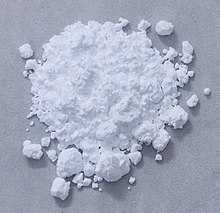 | |
| Names | |
|---|---|
| Other names Lutetium oxide, Lutetium sesquioxide | |
| Identifiers | |
3D model (JSmol) | |
| ChemSpider | |
| ECHA InfoCard | 100.031.591 |
| EC Number |
|
PubChem CID | |
CompTox Dashboard (EPA) | |
| |
| |
| Properties | |
| Lu2O3 | |
| Molar mass | 397.932 g/mol |
| Melting point | 2,490 °C (4,510 °F; 2,760 K) |
| Boiling point | 3,980 °C (7,200 °F; 4,250 K) |
| Solubility in other solvents | Insoluble |
| Band gap | 5.5 eV [1] |
| Structure | |
| Bixbyite | |
| Ia3 (No. 206) | |
| Related compounds | |
Other anions | Lutetium(III) chloride |
Other cations | Scandium(III) oxide Yttrium(III) oxide |
| Supplementary data page | |
| Lutetium(III) oxide (data page) | |
Except where otherwise noted, data are given for materials in their standard state (at 25 °C [77 °F], 100 kPa). | |
Lutetium(III) oxide, a white solid, is a cubic compound of lutetium sometimes used in the preparation of specialty glasses. It is also called lutecia. It is a lanthanide oxide, also known as a rare earth. [2] [3] [4]